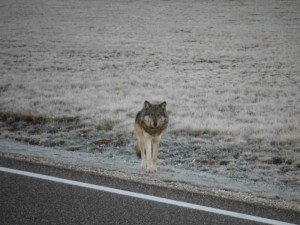 When I was 16, I planned what would become an annual canoe trip to the Boundary Waters in Northern Minnesota. My brother, four of my best friends and I packed into a Chevy Suburban and headed 6 hours north to the Canadian border. In the last 20 miles of our drive, we spotted them: two wolves lurking in the pine trees about 50 yards off the road. Sliding to a dusty stop, we piled against the passenger side of the Suburban and watched, eyes gaping, as they silently slid through the forest and out of our sight. A moment of awestruck silence was followed by about 15 minutes of freaking out. At this point in time, wolves were still on the endangered species list in Minnesota, and seeing a wolf in the wild was kind of like getting the chunk of bacon in the pot of baked beans when you have two older brothers; it just doesn’t happen. But it did happen. And in the past two months, several lucky Arizonans have had the same experience.
When I was 16, I planned what would become an annual canoe trip to the Boundary Waters in Northern Minnesota. My brother, four of my best friends and I packed into a Chevy Suburban and headed 6 hours north to the Canadian border. In the last 20 miles of our drive, we spotted them: two wolves lurking in the pine trees about 50 yards off the road. Sliding to a dusty stop, we piled against the passenger side of the Suburban and watched, eyes gaping, as they silently slid through the forest and out of our sight. A moment of awestruck silence was followed by about 15 minutes of freaking out. At this point in time, wolves were still on the endangered species list in Minnesota, and seeing a wolf in the wild was kind of like getting the chunk of bacon in the pot of baked beans when you have two older brothers; it just doesn’t happen. But it did happen. And in the past two months, several lucky Arizonans have had the same experience.
For the first time in about 70 years, a gray wolf has been spotted in Northern Arizona. Since early October, the wolf has been observed and photographed repeatedly near the North Rim of the Grand Canyon. Though efforts to capture the wolf, take a blood sample, and remove its inactive radio collar have been unsuccessful, the U.S. Fish and Wildlife Service (FWS) were able to collect a stool sample. From DNA tests on the sample, they were able to confirm that the wolf is a female gray wolf that has traveled approximately 450 miles from the northern Rocky Mountains.
At one point, gray wolves called all of North America home. However, by the 1930s, the gray wolf population had been nearly wiped out from the lower 48. In 1995, the species was successfully reintroduced into Yellowstone National Park. From their point of repopulation in the northern Rockies, the gray wolf has established packs and growing populations in the Pacific Northwest and throughout the Great Lakes region. The spotting of the Grand Canyon wolf shines a hopeful light on the possibility of gray wolves returning to their Southwestern home.
The pilgrimage of the Grand Canyon wolf, however, comes at a critical moment in the gray wolf’s story. The FWS has proposed that the gray wolf be stripped of its federal protections and taken off of the Endangered Species List. Though gray wolf populations have reached sustainable levels in many areas, many conservationists believe that they will fail to repopulate many of their historical habitats without the protections that have allowed them to attain their current success elsewhere.
Sources:
http://www.huffingtonpost.com/noah-greenwald/a-wolf-at-grand-canyon_b_6214932.html
http://news.yahoo.com/lone-wolf-traveled-more-450-miles-grand-canyon-202647116.html

































